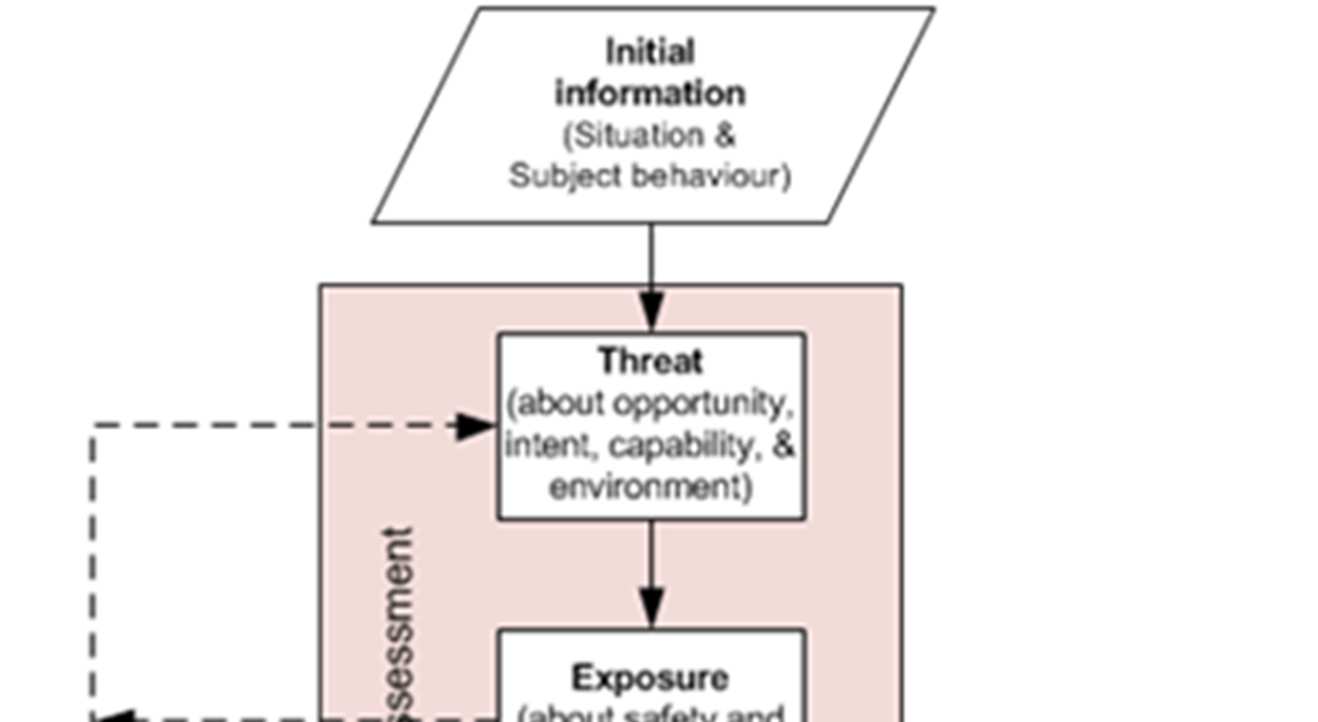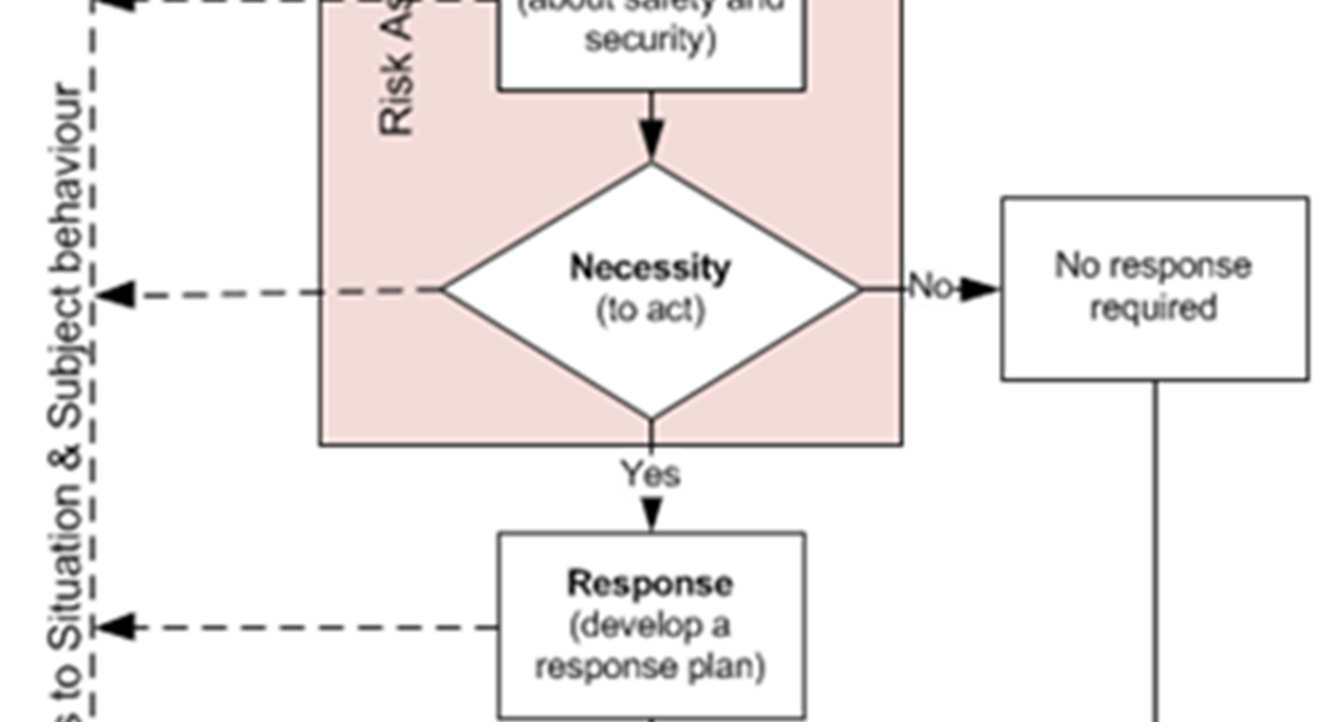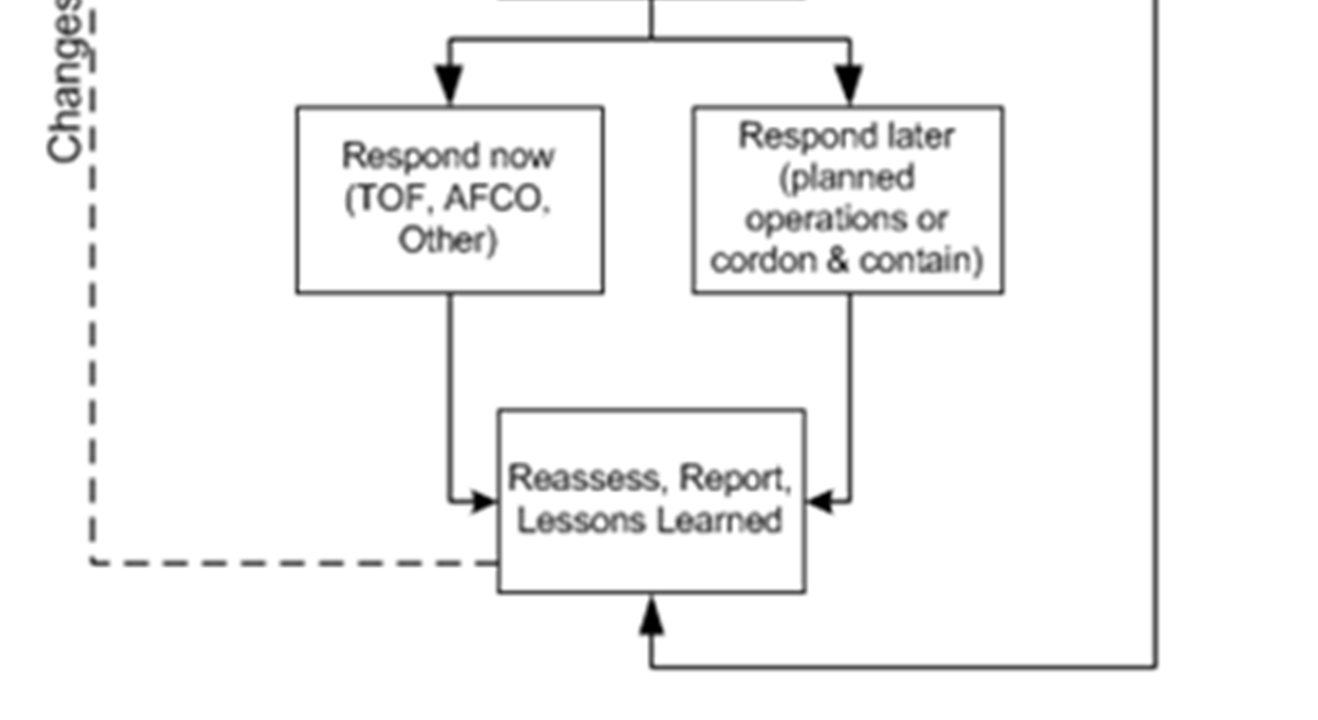TENR-Operational threat assessment
Overview
Executive summary
The Police threat assessment methodology (TENR) is a decision making
process that supports the timely and accurate assessment of information
directly relevant to the safety of Police and others. The response to any
given situation must be considered, timely, proportionate and
appropriate.
The overriding principle when applying TENR is that of 'safety is success'.
Victim, public and employee safety are paramount, and every effort must
be made to minimise harm and maximise safety. In addition, these critical
points apply:
• Police must apply TENR assessment methodology to all policing
situations that involve risk and have the potential to cause harm.
• TENR assessments must be carried out in conjunction with the Police
Integrated Tactical Training (PITT) and Use of force chapters of the
Police Manual, the
Tactical Options Framework (see PDF below),
associated staff safety technical training regimes, the Co-ordinated
Incident Management System, Civil Defence and Emergency
Management and other relevant Police Manual chapters and Standard
Operating Procedures.
• TENR can be conducted intuitively, worked through in a Police
notebook, or in detail as part of a planned operation, depending on
the circumstances.
Application and purpose
This chapter applies to all:
• constables
• authorised officers
• any other Police employees who from time to time may need to
conduct a threat or risk assessment
and:
• details the policy behind TENR and how it must be used.
Definitions
'Threat' means any individual/s, or any act/s, or
anything/s likely to cause harm or that have the
Threat
potential to hinder Police in the performance of their
duties.
'Exposure' means the potential for harm (physical or otherwise)
Exposure to people, or the security of places or things. Exposure can be
mitigated through assessment and planning.
'Necessity' is the assessment to determine if there is a need for
Necessitythe operation or intervention to proceed now, later or not at
all.
'Response' means the proportionate and timely execution of
ResponsePolice duties aided by the appropriate use of tactics and tactical
options.
'Risk' means the effect of uncertainty on Police objectives
Risk
combining the consequences of an event and the associated
likelihood of that event occurring.
'Suspect' means a person who poses a threat of harm to
Suspect themselves, other members of the public or Police.
TENR - operational threat assessment
TENR elements
TENR is a tool that enables better decision-making where:
T - the
threat is assessed
E - the
exposure is managed
N - the
necessity to intervene is considered
R - and any
response is proportionate, and based on a considered risk
assessment of threat, exposure and necessity.
Things to be aware of
When you apply TENR you must:
• comply with existing legislation and policy
• respond proportionately to any threat.
TENR is not an end in itself - where appropriate, it guides:



• effective training, specifically staff safety technical management
• robust systems
• operational preparedness
• accurate and timely intelligence
• effective communication
• quality supervision and leadership
• robust command and control framework
• the Tactical Options Framework.
TENR diagram
Roles and responsibilities
Employee responsibilities
Employees must take all reasonable care for their own health and safety,
and take reasonable care that their acts or omissions do not adversely
affect the health and safety of other persons. Each employee has a
responsibility to identify, assess and control risks within the workplace
and in the operational policing environment.
Employees are subject to the chain of command and have an overriding
responsibility to act reasonably, act in compliance with this chapter, and
act with legal justification during the execution of their duties.
Employees must ensure:
• their training certifications in all required competencies are current
• they carry their authorised equipment and appointments when they
deploy on duty
• they are fit for duty
• they understand and comply with legislation, policy and procedures
• they follow lawful orders and instructions
• they report identified training, knowledge and experience gaps to
their supervisor and seek guidance when necessary.
Any incident has the potential to develop and change quickly. It will not
always be possible to have complete and accurate information about the
incident at hand. In these instances, employees must be able to
demonstrate they followed relevant Police operating procedures during
the 'necessity' to act assessment.
Understanding the threat, exposure and necessity will guide planning
leading to the 'response'. The response must be proportionate to the
threat and the risk to Police and the public. In some instances - having
taken all of the circumstances into account - it might be appropriate to
delay an immediate response.
Employees should seek the advice and guidance of a supervisor or other
more experienced officers where a developing situation requires this
support.
All employees must understand and apply TENR within the operational
policing environment.
Supervisor responsibilities
Supervisors must ensure:
• all employees understand and apply TENR within the operational
policing environment
• before, during and after each phase of any operation or relevant
incident, the situation is assessed and reassessed
• employees are adequately trained, certified and equipped and the
equipment is current, in working order and is available to staff in
accordance with policy, practice and procedures
• faults or gaps in training and experience are identified, reported and
addressed and failure to meet training standards is performance
managed in accordance with the performance improvement
framework
• risky behaviours are identified and mitigated
• active leadership in risk situations
• appropriate debriefs are undertaken with employees; ensuring that
lessons learned are recorded through the Lessons Learnt Intranet
page, and information relating to new police operational procedures
supported by technical developments are shared, (subject to the
appropriate mandate from Police).
Police organisational responsibilities
Police has responsibilities to provide employees with:
• accurate policy and procedures,
• training,
• supervision and,
• suitable equipment
to most effectively manage the threats posed by the environment in
which they are operating.
Police must also take reasonable steps to:
• acquire and keep up to date knowledge of work health and safety
matters
• gain an understanding of the nature of the hazards and risks
associated with operational policing
• use appropriate resources and processes to eliminate or minimise risk
to health and safety from operational policing
• ensure appropriate processes for receiving and considering
information regarding hazards and risks, and for responding in a
timely way to that information.
TENR assessment procedures
Assessing the threat
Threat is about how serious the situation is (or could be), and the present
or potential danger the situation, environment, or suspect presents to
themselves, other members of the public or Police. In relation to a
suspected offence, it includes the suspect's intention to resist or avoid
arrest. Police must assess the threat posed by the suspect/situation based
on all available information including what they see and hear, and what is
known about the suspect/situation.
In order to better understand the threat of a situation or suspect, the
'threat' element of TENR is broken down into the following four sub-sets:
•
Intent •
Capability •
Opportunity •
Physical environment.
Follow these steps to assess the threat.
Step
Assess
In regards to a suspected offence, consider the situation
and/or the suspect's likely intent by asking yourself:
• What crime(s) has been
committed/detected/signalled?
• What current offending is being investigated?
• Is this a continuing threat?
• What is the likely current state of mind (based on
their actions) and mental health of the suspect?
1
Intent
• How committed is the suspect to achieve the criminal
aim?
• Is there propensity for violence / anti-social behaviour
if confronted?
• Is the suspect under the influence (or likely to be
under the influence) of any substances?
• What is the history of criminal activities and
associations?
• What do Police know about the suspect?
In regards to a suspected offence, consider if the suspect is
2
Capability physically capable of carrying out the threat by asking
yourself:
• Is there a history of firearm (or other weapon)
possession or use?
• Does the suspect have knowledge of and access to
counter-surveillance, computer or other electronics
equipment?
• Does the suspect own or have access to motor
vehicles?
• Has the suspect been imprisoned, involved in criminal
activities and associations, or do they have
knowledge of law enforcement process or procedures?
• Was the suspect ever targeted by Police?
• Does the suspect have known co-offenders,
associates, gang affiliations/associations? Will they
influence the suspect's behaviour?
• Does the suspect have family, neighbours and others
that can provide information or influence the
suspect's behaviour?
• What do Police know about the location?
In regards to a suspected offence, consider what means or
opportunity the suspect has to carry out any unlawful
intention or threat by asking yourself:
3
Opportunity
• Does the suspect have the capability or means (e.g.
firearm) with which to carry out the act?
• Is the suspect anywhere near the intended victim?
• Does the location support the suspect's intent?
In regards to any situation, consider the physical
environment Police are entering into and what risks are
present within that environment. These may be risks
associated with a suspect, other persons in the
environment, physical terrain, weather and lighting
conditions, fires, chemicals, gases or other environmental
factors:
4
Physical
• Are there problems with the approach, exposure, or
environment
access to the location?
• Does the terrain, vegetation, obstruction, or other
issues create hazards?
• If approaching a suspect's house, is it likely the
location is fortified, secured by alarms, lights, other
measures, guarded by dogs, or are there other
hazards?
• Has the location ever been used as a 'clan lab' or
does it pose a biological/safety hazard?
• How far away is additional support for the suspect?
• Are other subjects involved, or likely to become
involved, and what are their capabilities?
Assessing the exposure
Exposure is about the potential harm to Police employees, Police
operations, Police reputation and to others. In all instances, good
assessment and planning can mitigate the degree of exposure.
To understand exposure better, consider exposure in the following
subsets:
•
Safety •
Security.
Follow these steps to assess the exposure.
Step
Assess
Consider the type of injury or harm that could occur to Police
employees or the public, including victims, family and passers-
by. Ask yourself:
• How close are Police and others to the threat posed by the
suspect or situation, and how will Police control that
threat? For example, where a suspect's capability extends
to the use of firearms, Police must consider how close to
the source of that threat Police and others should be.
1
• Is there potential for force to be used against an employee
or the public?
Safety
• Is there a likelihood of harm from any source during the
intended deployment?
• Do Police have the appropriate resources (staff, tactical
options) available to manage the threat? How far away is
additional support?
• Am I current in training? Do I have the right skills for this
situation? Do I have current and working equipment to
protect me and others?
• What are the likely outcomes of the proposed Police
action?
Consider the security of the operation which, if not properly
2
managed, could lead to failure. Ask yourself:
Security
• Are your communications secured?
• Is there potential to lose or damage Police equipment?
• Can cordons be established and maintained to contain the
subject(s)?
Assessing the necessity to act now, later or not
at all
Any response to a situation must first take into account all available
information and must be supported by a clear assessment of the known
threat and exposure involved.
Follow this step to assess 'necessity' - whether to act now, later or not at
all - so that you come to an informed decision of how critical it is to
respond.
Step Assess
Every Police deployment must be timely and proportionate to the
threat and the exposure. Ask yourself:
• Is it appropriate to delay the response?
• Have you identified the suspect?
• Do you have processes and controls available to de-escalate
the threat to a manageable level?
1
• Are you trained and skilled to meet the threat?
• Do you have all the resources you need to respond safely
and effectively now or, should I delay the response until the
right resources are available?
• Is there a clear chain of command?
• What are the consequences to Police and/or public in
delaying the response?
Important: Any option must reasonably endeavour to
maximise safety and
minimise risk.
Developing a response
Before you respond
Discuss your intended response with your supervisor where the necessity
to respond permits.
Your response options
Consider the options available to you based on threat, exposure and
necessity, and plan a response that is timely, proportionate and
appropriate. Ask yourself:
• Should you delay action until other resources, skills or equipment are
available? Remember that caution is not cowardice, and there may be
good reasons to cordon and contain the subject while awaiting the
arrival of specialists - e.g. AOS, PNT.
• Is a more detailed investigation into the threat environment required
before you can act safely?
• Do you need to take prompt action to prevent further loss of life or
injury? Remember that even in active situations you must first
carefully assess the situation and make decisions, based on
appropriate and approved risk assessment methods, and supported
by your training and experience.
Note: Remember that in active response situations you must
continuously reassess your response based on the situation as it unfolds,
and the subject's behaviour.
Response methods
Any action you take in response to a suspect/situation related threat must
be in accordance with the Police Integrated Tactical Training (PITT) and
Use of force chapters of the Police Manual, the
Tactical Options
Framework (see PDF below), associated staff safety technical training
regimes, the Co-ordinated Incident Management System, Civil Defence
and Emergency Management and other relevant Police Manual chapters
and Standard Operating Procedures.
Recording and reporting
While recording and reporting is not part of the operational TENR threat
assessment process, these are things you need to consider:
Notebook recording
You should make use of your notebook in unplanned incidents, if time
allows, to record your TENR threat assessment - see notebook guidelines
in the 'Notebooks and Job Sheets' chapter.
Reporting the use of force
Use of force must be reported in a Tactical Options Reporting (TOR) form,
according to the reporting instructions in the 'Use of force' chapter.
Debrief
You should conduct or be part of a formal or informal debrief - see
'Debriefs' chapter.
Data updates and reports (lessons learnt)
You should provide data updates or reports as required by the 'Debriefs'
chapter. Lessons learned should be submitted via the Lessons Learnt
Intranet site.


